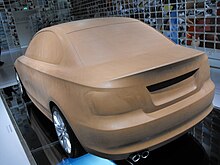| Revision as of 06:17, 25 December 2011 editHlcsky (talk | contribs)4 edits →Design studios← Previous edit | Revision as of 06:49, 25 December 2011 edit undoMER-C (talk | contribs)Edit filter managers, Autopatrolled, Administrators250,807 editsm Reverted edits by Hlcsky (talk) to last version by 200.225.227.180Next edit → | ||
| Line 8: | Line 8: | ||
| ==Design studios== | ==Design studios== | ||
| Before a new car model is launched, a long period of finding the right design takes place. Even today, ] are not sufficient to evaluate the quality of a design. Therefore 1:4 or even 1:1 models are built to get an impression of the final car. These models are created in clay, and usually consist of a wooden or iron frame which is covered with ]. Clay is loaded on top of the foam. Modelers then use various tools and slicks to finalise the shape of the car. | Before a new car model is launched, a long period of finding the right design takes place. Even today, ] are not sufficient to evaluate the quality of a design. Therefore 1:4 or even 1:1 models are built to get an impression of the final car. These models are created in clay, and usually consist of a wooden or iron frame which is covered with ]. Clay is loaded on top of the foam. Modelers then use various tools and slicks to finalise the shape of the car. | ||
| The website can be purchased:http://industrial-clay.com | |||
| ==Suppliers== | ==Suppliers== | ||
Revision as of 06:49, 25 December 2011
| This article does not cite any sources. Please help improve this article by adding citations to reliable sources. Unsourced material may be challenged and removed. Find sources: "Industrial plasticine" – news · newspapers · books · scholar · JSTOR (December 2009) (Learn how and when to remove this message) |


Industrial plasticine is a modeling material which is mainly used by automotive design studios. It was developed as an industrial version of plasticine or hobby clay.
Industrial plasticine is based on wax and typically contains sulfur, which gives a characteristic smell to most artificial clays. Often, the styled object will be used to create molds. However, largely because sulfur can interfere with some mold-making processes, especially if clay surfaces are unsealed surfaces and platinum-cure RTV (room temperature vulcanizing) silicone rubber is used, sulfur-free variants are now available; these are usually much lighter than sulfur-containing clays.
Design studios
Before a new car model is launched, a long period of finding the right design takes place. Even today, computer models are not sufficient to evaluate the quality of a design. Therefore 1:4 or even 1:1 models are built to get an impression of the final car. These models are created in clay, and usually consist of a wooden or iron frame which is covered with Styrofoam. Clay is loaded on top of the foam. Modelers then use various tools and slicks to finalise the shape of the car.
Suppliers
There are 2 main producers of industrial plasticine operating worldwide.
- Staedtler from Germany, which is also known for FIMO.
- Chavant, which was founded by the French chemist Claude Chavant and is now located in New Jersey.
- Dim Clay, founded by Eduardo Cinta in São Paulo - Brazil, provide sculpture supplies to all Latin America.